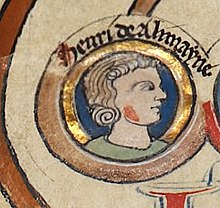Henry of Almain
| Henry of Almain | |
|---|---|
 | |
| Born | 2 November 1235 Haughley Castle, Suffolk |
| Died | 13 March 1271 (aged 35) Chiesa di San Silvestro, Viterbo, Italy |
| Burial | |
| Spouse | Constance of Béarn |
| House | Plantagenet |
| Father | Richard, 1st Earl of Cornwall |
| Mother | Isabel Marshal |

Henry of Almain (2 November 1235 – 13 March 1271), so called because of his father's German connections as King of the Romans (in England back then the elected German King was known as the King of Almayne[1][2]), was the son of Richard, 1st Earl of Cornwall and Isabel Marshal.[3][4]
Henry was knighted by his father the day after Richard was crowned King of the Romans at Aachen, the usual coronation place for German kings. Richard's coronation took place on 17 May 1257.[5]
As a nephew of both Henry III and Simon de Montfort, he wavered between the two at the beginning of the Barons' War, but finally took the royalist side and was among the hostages taken by Montfort after the Battle of Lewes (1264), was held at Wallingford Castle and later released.[6][7]
In 1268 he took the cross with his cousin Edward, who, however, sent him back from Sicily to pacify the unruly province of Gascony. Henry took the land route with Philip III of France and Charles I of Sicily.
While attending mass at Chiesa di San Silvestro (also called Chiesa del Gesù) in Viterbo on 13 March 1271, he was murdered by his cousins Guy {d.1288} and Simon the younger de Montfort {d.1271}, sons of Simon de Montfort, 6th Earl of Leicester, in revenge for the beheading of their father and older brother at the Battle of Evesham.[8] The deed is mentioned by Dante Alighieri, who took it upon himself to place Guy de Montfort in the seventh circle of hell in his masterpiece, The Divine Comedy, which was written at least 40 years after Henry's death.
Henry was buried at Hailes Abbey.
Marriage
Henry was married to Constance of Béarn (d. 1299), daughter of Gaston VII of Montcada, Viscount of Béarn, on 5 May 1269 at Windsor Castle. No children came of this union. And thus his half brother, Edmund, became the heir apparent of their father.
Notes
- ^ Richard Earl of Cornwall - Crusader and King of Almayne, twickenham-museum.org.uk
- ^ The archaic term Almayne, (Almain etc.) was derived from Anglo-Norman Allemaine, Almaine, itself derived from Alemaigne, the Old French word for Germany.
- ^ Tyerman, Christopher, England and the Crusades, 1095-1588, (University of Chicago Press, 1988), 128.
- ^ Prestwich, Michael, Edward I, (Methuen London Ltd, 1988), 5.
- ^ Richard, 1st Earl of Cornwall, thepeerage.com
- ^ Goldsmith, Oliver, The history of England, from the earliest times to the death of George II, (London, 1800), 284.
- ^ Treharne, Reginald Francis, and Ivor John Sanders, Documents of the baronial movement of reform and rebellion, 1258-1267, (Oxford University Press, 1973), 47.
- ^ Maddicott, J. R., Simon de Montfort, (Cambridge University Press, 1994), 370.
References
- Goldsmith, Oliver, The history of England, from the earliest times to the death of George II, London, 1800.
- Maddicott, J. R., Simon de Montfort, Cambridge University Press, 1994.
- Prestwich, Michael, Edward I, Methuen London Ltd, 1988.
- Treharne, Reginald Francis, and Ivor John Sanders, Documents of the baronial movement of reform and rebellion, 1258-1267, Oxford University Press, 1973.
- Tyerman, Christopher, England and the Crusades, 1095-1588, University of Chicago Press, 1988.
See WH Blaauws The Barons' War (ed. 1871); Ch. Bmont1 Simon de Montfort (1884)
- This article incorporates text from a publication now in the public domain: Chisholm, Hugh, ed. (1911). Encyclopædia Britannica (11th ed.). Cambridge University Press.
{{cite encyclopedia}}: Missing or empty|title=(help)
